No-code platforms are tools that help people with little to no coding knowledge build applications, websites, and more with their drag-and-drop interface and customizable code templates. These tools offer pre-built components, AI assistance, and step-by-step guidance, taking software development to the masses.
No-code is a rewarding solution for solopreneurs and small-scale startups to start development without hiring developers. There are multiple such tools in the market, and most of them have free tiers or trials — allowing risk-free entry into the custom software space.
Our in-depth research helped us curate a list of the best no-code platforms for businesses and individuals based on their use case fit, integrations, price, and user feedback.
- 1. Knack – Best for Database-Driven Web Apps
- 2. m-Power – Best to Build Enterprise Applications
- 3. Zoho Creator – Best for Business Apps
- 4. Bubble – Best for Small to Medium Business
- 5. Mendix – Best for AI-Powered Development
- 6. Quickbase – Best for Project Management Apps
- 7. Retool – Best for Internal Tools
- 8. Google AppSheet – Best to Integrate with Google Workspace
- 9. Creatio – Best for Process Automation
- 10. Airtable – Best for Flexible Database Applications
- 11. Microsoft Power Apps – Best for Microsoft Ecosystem Integration
- 12. Caspio – Best for Dashboard
- 13. Kissflow – Best for Workflow Automation
- 14. Webflow – Best to Create Websites
- 15. Adalo – Best for Mobile Applications
- 16. Softr – Best for Building Web Apps from Airtable
- 17. Glide – Best for Converting Spreadsheets into Apps
- 18. Stacker – Best for Customer Portals
- 19. Carrd – Best for Single-Page Websites
- Show less
You can trust Geekflare
Imagine the satisfaction of finding just what you needed. We understand that feeling, too, so we go to great lengths to evaluate freemium, subscribe to the premium plan if required, have a cup of coffee, and test the products to provide unbiased reviews! While we may earn affiliate commissions, our primary focus remains steadfast: delivering unbiased editorial insights, and in-depth reviews. See how we test.
1. Knack
Best for Database-Driven Web Apps
Knack helps teams build no-code apps with its templates, AI-driven workflows, and live help from its experts.
Users can start quickly with its pre-built templates, which cover business apps for inventory management, project management, self-serve customer portals, quote/invoice generators, purchase order management, and more.
The platform allows users to connect Microsoft Excel or Google Spreadsheets to create a no-code relational database. It enables users to search and query data across all apps in one go, in addition to powerful built-in filters for result segmentation. Knack empowers admins to view the database version history to track record creation and updates.
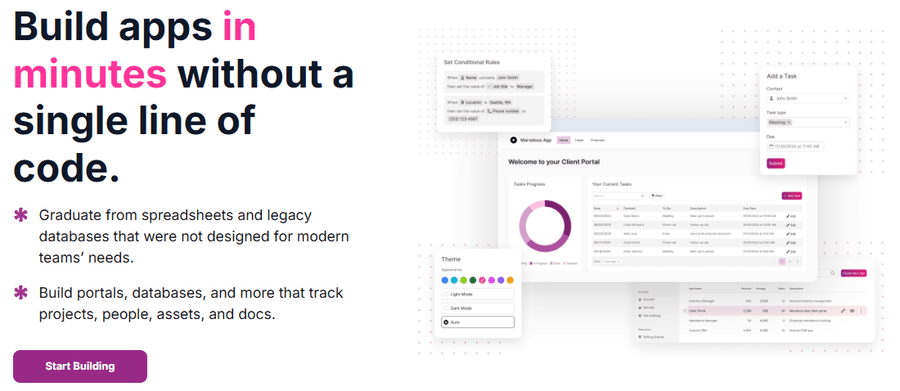
Knack’s AI builder lets teams build apps with minimum input, such as target users, use cases, and basic information. Thereafter, users can take charge and customize the app to suit specific needs.
The platform offers multiple data reporting options, including pivot tables, pie, line, bar, and area charts. You can also build personalized charts, add equations/calculations, and use custom filters/queries.
You can customize further by adding e-commerce abilities to the app and selling goods and services with built-in payment support for one-time payments, add-ons, and subscriptions. Teams can also track payments and revenue to clearly understand their venture’s profitability.
Expert users can build custom automation workflows with JavaScript injection to set up logic-based automated actions.
Knack allows integrations with 30+ apps, such as Asana, Dropbox, Google Docs, Office365, MySQL, Salesforce, Slack, Zendesk, and Zoho.
Knack Pros
AWS-based infrastructure for scalability and top-notch security
Multiple login protection measures, such as IP blocking, SSO, and passwords
Design flexibility with custom CSS and JavaScript
Knack Cons
Default designs are subpar
Suffers from slow load times
Knack Pricing
Users can try Knack with its 14-day, no-credit-card trial. Afterward, new customers can choose from discounted plans starting at $19/month.
- Starter: $19/month
- Pro: $49/month
- Corporate: $219/month
2. m-Power
Best to Build Enterprise Applications
m-Power is a low-code platform flexible enough to function as no-code or full-code to help enterprises customize every aspect of their applications. Applications developed with m-Power are fully responsive and adapt to the target operating system, including desktop and mobile platforms.
It supports several database systems, including MySQL, MSSQL, Snowflake, and PostgreSQL. You can build multiple types of applications, such as client portals, CRM systems, and mobile apps, with its “code-optional” workflows.
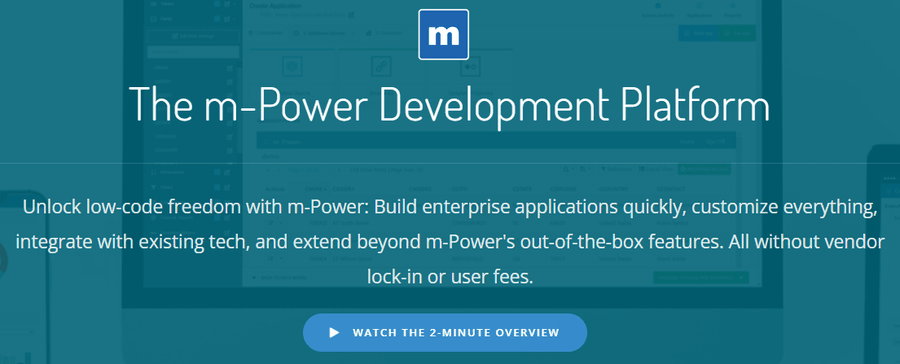
m-Power provides enterprise-level security with native features such as user access control and multi-tenant application security. It easily integrates SAML, OAuth2, and Active Directory.
One of the standout features of m-Power is that teams can export and host their application at the platform of their choice. There is no vendor lock-in; businesses can deploy applications on-premises and with cloud providers as needed. Plus, the licensing is free from limitations, such as a fixed number of users or applications per plan.
You can license all the m-Power templates or specific ones to reduce the financial overhead. Businesses can choose plans that allow free distribution to their clients.
m-Power Pros
Flexibility to opt for no-code or full-code workflows
On-premise and cloud deployment flexibility
Perceptual license availability
m-Power Cons
Interface is more suited for low-code applications
Lacks upfront pricing
Data export is limited to excel sheets
m-Power Pricing
There are no listed subscriptions. Instead, teams must contact m-power support and state their exact needs to get price quotes, starting at $1500/month.
3. Zoho Creator
Best for Business Apps
Zoho Creator combines visual app building and code blocks to help users build custom business apps, portals, and internal systems that can run on desktop and mobile platforms.
This starts with AI-assisted data import from local drives, cloud storage providers, external databases, or any third-party with APIs. Then, data from different sources is migrated into a unified information pool while junk and duplicate data are removed. With Zoho AI, you can visualize data and ask questions about it to get valuable insights.
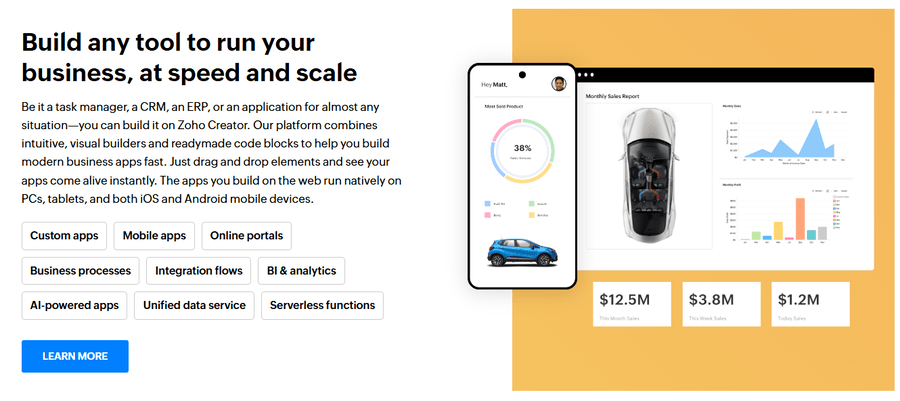
Once you build apps with Zoho Creator, they work on every platform without needing rework. Also, apps for iOS and Android get created automatically. All aspects get amplified with 600+ custom and pre-built integrations.
You can represent your brand through in-depth app personalization with brand colors, logo, domain, and a fully white-labeled experience. Teams can also auto-translate text to match with the end users.
Zoho Creator enables admins to implement granular user roles, secure login protocols (SAML SSO, MFA), and keep an audit trail of every change. Additionally, the platform encrypts everything on its platform and is GDPR, HIPAA, and SOC 2 compliant.
You can add AI capabilities such as forecasting, data extraction, object detection, sentiment analysis, bill processing, and more without writing code. The platform also allows you to extract data in multiple formats, such as XLSX, PDF, HTML, XML, JSON, CSV, and TSV.
While people can start afresh, Zoho Creator also has pre-built apps for employee, vendor, logistic, and quotation management to serve basic business needs.
Zoho Creator Pros
Easy to use drag-and-drop interface
Template apps for getting started quickly
IDE for app customization
Zoho Creator Cons
Integration with non-Zoho tools requires enterprise license
Tech support is slow to respond
Zoho Creator Pricing
After a 15-day free trial, you can subscribe to the below-mentioned plans or contact Zoho for a tailored offering.
- Standard: $8/user/month
- Professional: $20/user/month
- Enterprise: $25/user/month
4. Bubble
Best for Small to Medium Business
Bubble is a no-code platform for building complex web apps like Facebook or eBay for desktop and mobile browsers. Its customizable templates help you quickly develop apps.
You can effortlessly connect LLMs like ChatGPT and Claude to make genAI-powered applications. Bubble’s AI page designer allows you to type natural language prompts to design web pages and entire user experiences.
Though teams can opt for a strict no-code approach with Bubble, it still allows customization with code injections and over 6,500 integrations, including Airtable, Google Sign-In, Box, Stripe, Zapier, Amazon, Asana, Github, PayPal, and more.

Bubble’s multilingual capabilities allow app content to be translated into 80+ languages based on user location without custom code. You can also extend language support beyond what’s already provided. Moreover, the platform doesn’t put any rigid limits on users, data, or traffic.
Bubble features version control to revert to any point in history with ease. Teams can also check changes on staging instances before pushing them live.
This level of development simplicity meets top-notch security with Bubble’s SOC 2 Type II and GDPR compliance. Admins can enforce security policies like two-factor authentication, SSO, and granular data access to ensure data security. Bubble is built on AWS, inheriting industry-leading security protocols, including AES-256 encryption at rest and TLS for data in transit. It also supports Cloudflare integration to put an additional security layer on top.
Analytics is another strong aspect of Bubble. Users get a pinpoint analysis of their apps’ most used parts. Moreover, Bubble supports integration with popular analytics platforms, including Mixpanel, Google Analytics, or Segment.
The platform also features real-time collaboration with up to 40 members so that teams can work on the same project simultaneously.
Bubble Pros
Excellent features and integrations for web app development
Suitable for quickly building prototypes
Ease to use as indicated by multiple G2 reviews
Bubble Cons
No functionality to build mobile apps as yet
Complicated data export
Random glitches hinder the user experience
Bubble Pricing
Bubble has a forever-free plan for absolute beginners. It allows solo development without publishing. The paid plans are listed below and provide additional features, such as custom domains.
- Starter: $29/month
- Growth: $119/month
- Team: $349/month
- Enterprise: Custom
5. Mendix
Best for AI-Powered Development
Medix presents a single IDE (Studio Pro) for low-code/no-code development, catering to citizen developers and skilled coders alike. Medix Studio Pro allows visual application development and lets users harness generative AI capabilities to get the job done faster.
The platform has a markdown-capable chat interface integrated into Studio Pro to answer any dev-related queries. It retains context in extended conversations and cites resources. It also helps users with application modeling and logic.
Mendix Chat (now Maia) assists developers in building valid workflows by suggesting the correct sequence of activities. Users are free to connect genAI models of their choice, including GPT, DALL-E, Claude, Llama, and more.

You can deploy applications on Medix Cloud or with the cloud provider of your choice, such as AWS, Azure, Red Hat OpenShift, and Google Cloud. It provides flexibility to deploy applications on public, private, or dedicated cloud servers.
Mendix supports fine-grained access controls and identity management. Teams can connect their existing identity providers, including Entra ID, Okta, Auth0, Ping Identity, and ADFS. It enables admins to keep a bird’s-eye view on the activities, version information, application roles, resources, and more.
You can also integrate services of your choice with ready-built connectors (for AWS, OpenAI, Dropbox, Airtable, Hubspot, etc.) from the Mendix marketplace. Developers can also build custom integrations with Mendix, which supports industry-standard protocols like REST, SOAP, JDBC, and OData.
Mendix Pros
Build web and native mobile apps from a single interface
On-premises and cloud deployment
99.5% to 99.95% Uptime guarantee for paid plans
Mendix Cons
Prices are exorbitant for startups
Official data export is limited to Excel only.
Mendix Pricing
With Mendix, getting started is free, and publishing to its own cloud is included. However, paid users have access to more deployment options and features, such as a project dashboard, tech support, and an uptime guarantee.
- Basic: $75/month
- Standard: $998/month
- Premium: Custom
6. Quickbase
Best for Project Management Apps
Quickbase allows teams to efficiently run their most complex projects by letting them develop no-code solutions with visual, AI-assisted workflows.
Its template library gives access to hundreds of sample apps for many business-related aspects, such as shop floor management, service automation, inventory management, CRM, incident reporting, and safety audits. Businesses can also benefit from its pre-built components and plugins for quicker development.
Quickbase’s AI integration enables users to develop custom apps like forms, reports, and dashboards. It recommends new tables and fields for building and iterating apps for refinements.

It also allows admins to enforce app access controls and cell-level permissions for setting varying access levels per table, record, and field.
Organizations can distinctly brand multiple apps in their portfolio on a one-by-one basis. Alternatively, businesses can brand all the apps in one go.
Quickbase encrypts all data with AES-256-bit encryption at rest and TLS in transit. Enterprise users can also deploy advanced security by using customer-specific encryption keys and rotating them periodically. Moreover, admins can configure who gets access to specific integration connectors or can invite new users.
Teams can connect Quickbase with third-party apps such as Outlook, Slack, Dropbox, Amazon S3, Asana, Jira, Zapier, Salesforce, and more.
Quickbase Pros
Flexible user permissions and strong data security
Extensive pre-built app templates
Excellent third-party integrations
Quickbase Cons
Cannot export more than one table at a time
Absence of user-controlled backups
Expensive paid plans and no-free plans
Quickbase Pricing
Quickbase offers a 30-day free trial that allows no-risk test runs. Afterward, the plans mandate a certain minimum number of users unless you opt for its “fully customizable” enterprise subscription.
- Team: $35/user/month
- Business: $55/user/month
- Enterprise: Custom
7. Retool
Best for Internal Tools
Retool enables users to build web apps, native mobile apps, custom databases and deploy workflow automation. Additionally, Retool allows writing code, thereby providing extensive customization and integration possibilities.
While most of Retool is built for developers, teams can easily build internal apps with its low-code/no-code approach and 100+ pre-built components. It has over 40 elements to handle multiple input types, such as search, ratings, recording, uploads, and checklists, with in-built formatting and data validation support.
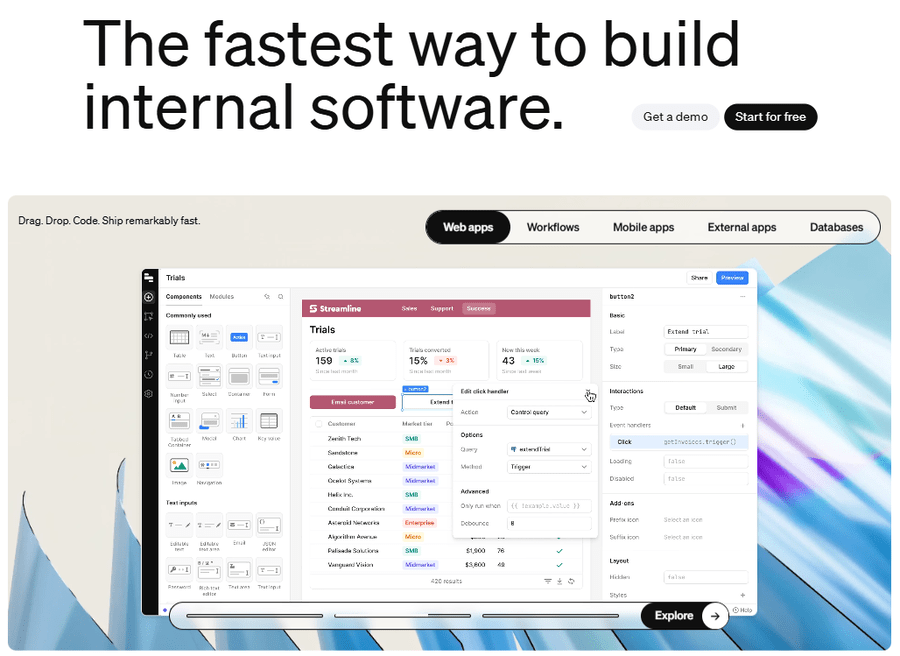
Users get professional-looking frontends to reduce workload. However, you can easily customize your apps with or without code. Teams get support for multiple content types, bulk editing, and flexible pagination options for effective content customization, creation, and discovery.
For teams, app security includes access control, SSO, versioning, and audit trails.
Retool lets businesses integrate any LLM from OpenAI, Anthropic, and Azure to include AI functionality like text summaries, creating images, and more. Businesses are also free to connect any other custom LLM of their choice as needed.
Users can self-host internal apps developed with Retool or use its cloud.
Retool integrates with MySQL, PostgreSQL, Elasticsearch, MongoDB, Amazon S3, Asana, GitHub, Jira, Salesforce, SendGrid, Zendesk, Shopify, Slack, and more.
Retool Pros
Flexible app development options, including no-code to code-everywhere
Native integrations with a lot of database management systems
AI integration adds multiple functionalities
Retool Cons
Paid plans are expensive
Overwhelming for users looking for strictly no-code deployment
Retool Pricing
Retool enables teams to develop unlimited web and mobile apps even with the free tier, however, with a very restrictive 5-user limit. Paid plans open up to more users, collaborators, etc., with the following subscriptions.
- Team: $10/Standard user/month + $5/End user/month
- Business: $50/Standard user/month + $15/End user/month
- Enterprise: Custom
*Standard user: Those who build app during a billing cycle
**End user: Enabled users who did not develop during a billing cycle
8. Google AppSheet
Best to Integrate with Google Workspace
Google AppSheet is a “true” no-code app creation platform that allows developing desktop and mobile apps without writing a single line of code. The AppSheet editor lets you build prototypes quickly and provides AI-powered suggestions for customizations.
AppSheet connects to a vast array of data sources, including Google Sheets, Google Drive, Microsoft Excel, Cloud SQL, Apigee, Azure SQL, AWS, Salesforce, Smartsheet, OData, etc., in addition to its native data repository.
You can create apps by describing the application and letting Google’s Gemini build it in minutes.
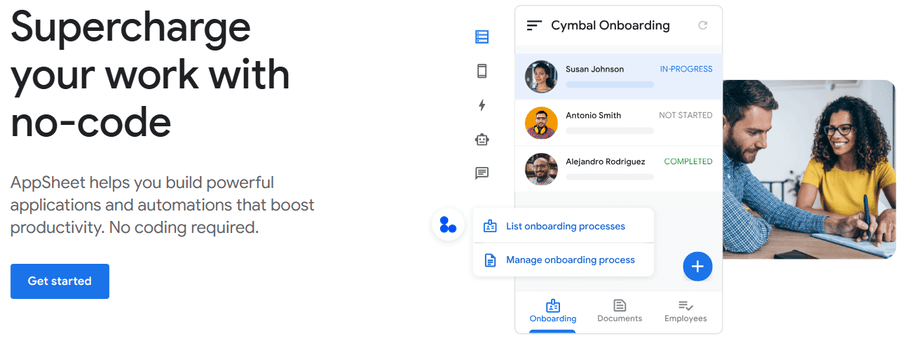
AppSheet is tightly integrated with Google Workspace. It allows creating apps, live chatting, preparing reports, and more, while in sync with Workspace apps such as Gmail, Chat, Sheets, Calendar, Meet, and Docs.
You also get customized features, branding, security, and UX options with AppSheet. Additionally, you can control users with role-based permissions, authentication, security, and usage reports. You can build bots to handle your manual tasks automatically. While building, you can add workflow logic using conditions, branches, and triggers.
Furthermore, AppSheet lets you implement ML methodologies, such as recognizing optical characters and document processing. You can connect to applications like Dropbox, Salesforce, Office 365, and Google Workforce to gather and utilize data and get service-specific benefits.
Since building apps can be challenging, even without code, AppSheet has 60+ app templates you can directly copy or customize further.
Google AppSheet offers integration with third-party apps and services, including Office 365, Dropbox, Salesforce, Big Query, SQL databases, Apigee, REST APIs, and OData.
Google AppSheet Pros
Complete Google Workspace integration
Multiple app templates to get started quickly
Best for prototyping and individual use
Google AppSheet Cons
No data export for public apps
Limited customization options
Google AppSheet
AppSheet allows fully-featured app development and testing with up to 10 users for free. Afterwards, paid plans kick in starting at $5.
- Starter: $5/user/month
- Core: $10/user/month
- Enterprise Plus: $20/user/month
9. Creatio
Best for Process Automation
Creatio combines no-code and generative AI, allowing web, desktop, and mobile app development with multiple customizations.
It lets users without deep technical skills successfully develop business applications and automate workflows while leveraging powerful ML/AI models. Creatio’s no-code app designer enables users to create and modify pages, views, data models, workflows, and integrations.

The platform lets users achieve workflow automation for the most complex of processes. You can automate and manage unstructured processes, in addition to running multiple workflows simultaneously.
Its Freedom UI designer includes a library of predefined views, widgets, and templates for fast-track app development.
Admins can enforce granular access controls and column and field-level permissions. Moreover, app authentication is supported with SSO integration for a seamless login experience and security.
Besides ready-made connectors, Creatio supports an extensive range of standard open protocols, such as REST, SOAP, ODATA, OAuth, and LDAP, helping it easily integrate with third-party systems and applications.
Creatio Pros
Workflow automation and execution flexibility
App customization via scripts
Creatio Cons
Steep learning curve for beginners
Pricing is expensive for small businesses
Creatio Pricing
You can apply for a demo or try Creatio for free. The paid plans start for a minimum of 5 users.
- Growth: $25/user/month
- Enterprise: $55/user/month
- Unlimited: $85/user/month
10. Airtable
Best for Flexible Database Applications
Airtable Cobuilder is a no-code platform to turn data into a visually efficient and customizable app experience. Airtable’s resourceful templates help users start by covering project management, marketing, sales, CRM, HR, and more.
Syncs and real-time commenting ensure teams can collaborate easily. Airtable also allows you to create customized workflows for every member.
With Airtable AI, users can harness generative AI capabilities. Teams can use AI to obtain assistance for routine tasks, such as data analysis, preparing summaries, translation, and gaining insights.
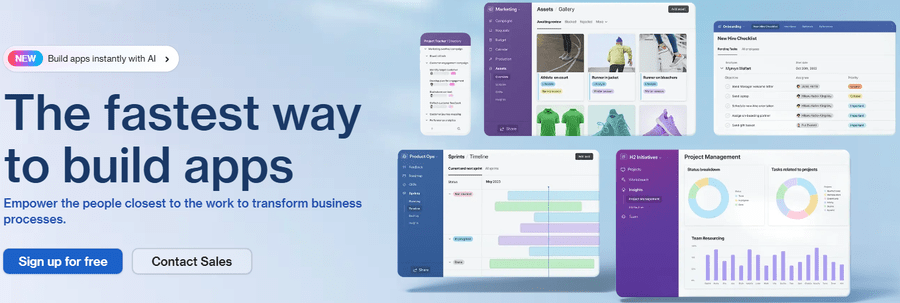
It has 47+ pre-built extensions to add custom visuals and functionality to existing Airtable databases. You can add more customizations using JavaScript to serve specific use cases.
Admins can control everything with table and field-level permissions. Moreover, fine-grained sharing control, group sharing, and read-only interfaces provide robust security and privacy.
Airtable keeps revision and snapshot history to allow admins to view the entire database activity log and revert to a previous state.
The platform integrates with industry-leading services, such as Asana, Dropbox, Evernote, Facebook, GitHub, Google Calendar, Gmail, Google Drive, Jira, Miro, Salesforce, and Stripe.
Airtable Pros
Plenty of data visualization options, including lists, grids, Kanban, calendar, and more.
Easy to use
Real-time collaborative app development
Airtable Cons
Limited native export options
Expensive for startups
Airtable Pricing
Airtable’s free tier allows collaboration with up to 5 editors. However, it lacks sync with external databases, extensions, granular control, and more. These are provided in the paid plans, which are listed below.
- Team: $20/seat/month
- Business: $45/seat/month
- Enterprise Scale: Custom
11. Microsoft Power Apps
Best for Microsoft Ecosystem Integration
Power Apps is a Microsoft offering for building low-code apps with assistance from its generative AI chatbot, Copilot. Users can describe the app requirements and let Copilot deliver the first draft. Next, you can take assistance from the templates, make edits with its drag-and-drop interface, and input code if needed.
The platform lets businesses control all apps from a single dashboard. Admins can manage the app lifecycle and allow anyone to get creative without posing security risks to the entire organization.
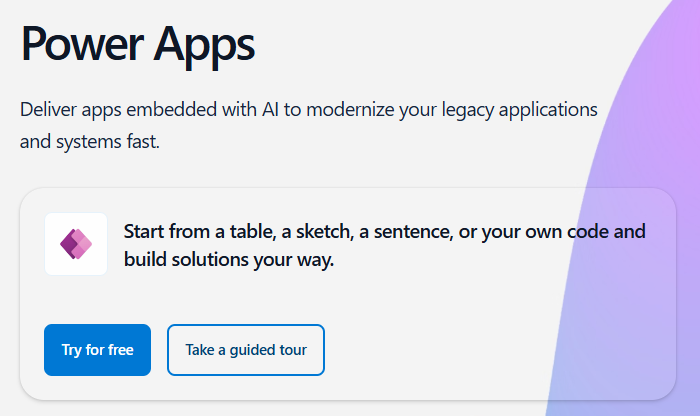
The standout feature of Power Apps is the tight-knit integration with the Microsoft ecosystem, especially Azure, GitHub, and Visual Studio.
Power Apps enables teams to build apps for any device, with targeted user experience. You can see the base code and tweak or extend it to provide additional functionality. Code extensions are supported via Microsoft Power Fx — a low-code programming language applicable across Microsoft Power Platform.
Since everything gets handled with Microsoft Dataverse, Power Apps provides enterprise-level security features. It has 1200+ connectors to integrate data from third-party sources, and you can build custom solutions for more.
Power Apps can also work without an internet connection. Businesses can deploy native mobile experience with Power Apps for iOS and Android.
Microsoft Power Apps Pros
Robust integration with Microsoft apps
Easy to use for beginners
Custom code extensions
Microsoft Power Apps Cons
Costly option for making complex applications
Technical documentation is limited
Microsoft Power Apps Pricing
Power Apps comes with a generous free subscription, allowing the building of websites and apps, connection to third-party databases, and access to Microsoft Dataverse. However, you need to upgrade to its paid plans for AI-assisted development, unlimited workflows, and greater administration prowess.
- Premium: $20/user/month
- Premium (with a minimum of 2,000 seats): $12/user/month
12. Caspio
Best for Dashboard
Caspio is a low-code/no-code platform for building custom business applications, with no limits on internal and external users.
Hosted on AWS and powered by Microsoft SQL Server, Caspio delivers high performance with built-in scalability and robust security features, including identity management, activity logging, and data encryption.
Caspio’s database management system supports multiple join types, maintains referential integrity, offers lookup fields, and includes cascade update/delete functions for managing related records.

The platform comes with a native AI assistant that allows users to design apps with natural language prompts. The genAI chatbot can create and regenerate tables and provide multiple results, enabling users to pick the best option for their needs.
Expert users can utilize common SQL functions for custom data manipulations, giving them better control and flexibility than what the platform offers.
Developers can extend Caspio functionality by connecting third-party apps and services with webhook and REST API integration. Alternatively, users can search through the Caspio Marketplace to find a pre-built integration of their choice.
Caspio easily integrates with leading payment providers (PayPal and Stripe) and cloud storage platforms, including Amazon S3, Box, Dropbox, Google Drive, and Microsoft OneDrive.
Caspio Pros
Unlimited users in every plan
Enterprise-grade security and compliance
Effortless setup and small learning curve
Caspio Cons
Can’t build native mobile apps
Advanced features like revision history, AI assistance, etc., are paid add-ons
Caspio Pricing
Although Caspio lacks a free plan, users can request a 14-day trial. Thereafter, teams can upgrade to the paid tiers, all of which come with unlimited user seats.
- Starter: $90/month
- Professional: $270/month
- Enterprise: $2,025/month
13. Kissflow
Best for Workflow Automation
Deploy applications with Kissflow’s no-code platform and automate your tasks to save time. It’s a no-code/low-code app builder that lets teams share workflows with their developers and invite others to participate in designing and app development.
Add forms with 20+ input types into your applications. Kissflow allows you to connect data and manage it from a single place. You can also create robust workflows for your teams with conditional steps and triggers. Additionally, Kissflow helps you assemble dashboards using advanced components.
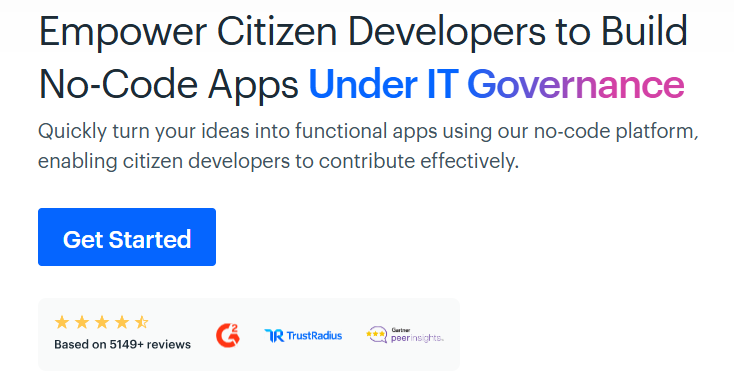
Kissflow enables customizable workflow creation to manage business processes across teams. It helps share work, combine data from different sources, automatically assign tasks, and identify constraints with its visual representations.
You will find plenty of ready-made integrations to third-party tools to extend an app’s usability, with scope for custom extensions as well.
Kissflow’s pre-built applications can be accessed from its dashboard. It allows you to prioritize and fix bugs effectively, evaluate business operations and impact, streamline users’ applications, and do more.
Kissflow empowers users to add an extra layer of security to monitor application performance. You can grant access to your team members by assigning roles-based permissions. Admins can check out activity history to verify every change. Kissflow is also compatible with advanced sign-in security options such as multi-factor authentication, SSO, IP whitelisting, and SAML and SCIM.
Kissflow Pros
Robust security protocols, including SSO, IP restrictions, MFA, etc.
Excellent customer support, as indicated by G2 reviews
Code extendibility
Kissflow Cons
Expensive for small-scale organizations
Lacks on-premise or custom deployment
Kissflow Pricing
Kissflow does not offer a free tier or trial. It has only two plans: Basic (starting at $1500/month) and Enterprise (quote-based).
14. Webflow
Best to Create Websites
Webflow is a no-code website builder for non-developers who want to build professional websites. This gives you complete control over HTML elements and CSS properties to create basic to most complex websites without any coding.
You can create custom animations, including interactive elements that come live with user actions. Users can bring in content from Webflow’s integrated CMS to any page and edit any element to perfection.
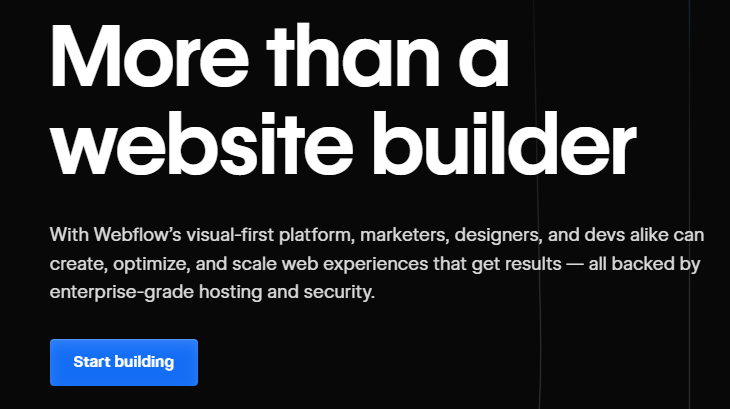
Teams can customize a single webpage and set selected elements, such as header and footer, to be reflected everywhere. Subsequently, users can publish from Webflow or export code to go live on other servers.
Webflow allows custom web experiences based on user geolocation. This includes specific web pages, images and alt text, blog posts, and more. Additionally, teams can control element visibility and use certain styles and fonts to appear for a particular locale.
Webflow has an extensive list of integrations, including Figma, Microsoft Clarity, HubSpot, Typeform, Jasper, and IFTTT.
Webflow Pros
Deployment choice
Real-time internal and external collaboration
Excellent design flexibility with custom HTML, CSS, and JavaScript
Webflow Cons
Customizations can feel overwhelming to beginners
Lack of auto-optimization for mobile platforms
Webflow Pricing
Webflow has a limited-featured free plan, which allows publishing to Webflow.io domain and 1GB/month bandwidth. Greater bandwidth, publishing to a custom domain, SEO controls, and more can be availed with the below-mentioned subscriptions.
- Basic: $14/month
- CMS: $23/month
- Business: $39/month
- Enterprise: Custom
15. Adalo
Best for Mobile Applications
Adalo is used for developing native applications for the web and mobile platforms (iOS and Android), with one-click publishing support to the Play Store, App Store, and a custom domain.
It works via a freeform visual app-building interface with many pre-built components and a plugin marketplace to extend functionality. Adalo also lets users go into “developer-mode” and design custom components themselves.

Every subscription allows teams to add unlimited screens, use 50+ components, build advanced logic, and input custom formulas — all without writing code.
Users can build their databases in Adalo itself or connect to a third-party service, such as Xano or Airtable. More integrations include Zapier, Gmail, Stripe, Quickbooks, and Mailchimp.
Admins can check the version history and restore previous designs. Adalo also lets teams track their app users and input their current geolocation for multiple use cases, such as address autocomplete and finding nearby services or popular destinations.
Adalo Pros
Highly customizable interface to build prototypes
One can hire Adalo-certified experts to build apps
Adalo Cons
Has scalability issues
Lack of third-party integrations
Adalo Pricing
Users can publish web apps for free on an Adalo-hosted domain. Publishing to app stores, greater usage limits, custom actions, and more are reserved for paid users, however.
- Starter: $36/month
- Professional: $52/month
- Team: $160/month
- Business: $200/month
16. Softr
Best for Building Web Apps from Airtable
Softr is a no-code tool that allows you to turn your Airtable or Google Sheets into web applications or simplified client portals. It can connect to many other data sources, such as MySQL, PostgreSQL, MariaDB, and Supabase.
It has a few pre-built blocks, such as lists, charts, forms, tables, calendars, maps, etc., which users can directly drag to their app interface without much input.
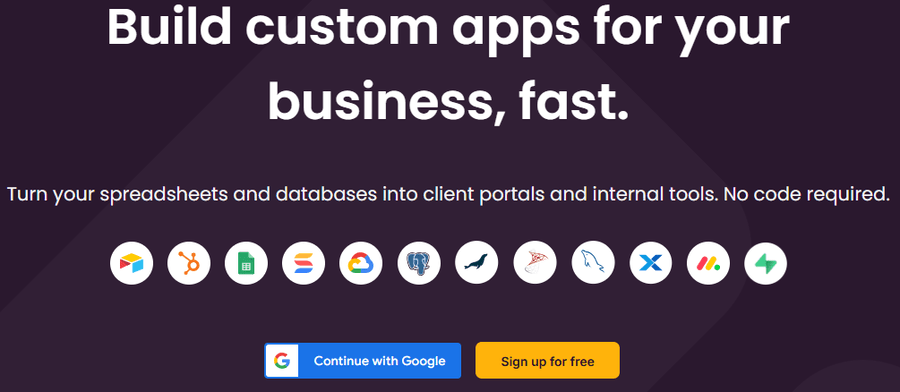
Admins can invite any number of collaborators to build their Softr app. Likewise, there is no limit on the visitors (non-logged-in-users) you can have on your app’s public pages.
Teams can implement granular view and edit permissions by creating user groups. Softr apps support various login options for app users, including passwords, Google sign-on, and verification codes. Admins can also control logins based on their users’ email domains.
Softr integrates with 30+ business apps, such as Google Analytics, Intercom, Stripe, PayPal, Mailchimp, Typeform, Calendly, Vimeo, YouTube, and Zapier.
Softr Pros
Simple interface and easy to use
Custom CSS and JavaScript for extended customizations
Quick and helpful support
Softr Cons
Can’t build mobile native apps
Limited customizations
Softr Pricing
Softr is one of the few no-code platforms that lets users publish apps on a custom domain and have unlimited visitors even with the free tier. Higher subscriptions start from $49.
- Basic: $49/month
- Professional: $139/month
- Business: $269/month
- Enterprise: Custom
17. Glide
Best for Converting Spreadsheets into Apps
With its 400+ customizable templates, Glide is one of the easiest ways to turn databases into front-end applications. You can start by connecting external databases, such as Google Sheets, Excel, Airtable, MySQL, and PostgreSQL, and customize ahead with Glide’s advanced logic and intuitive visual interface.
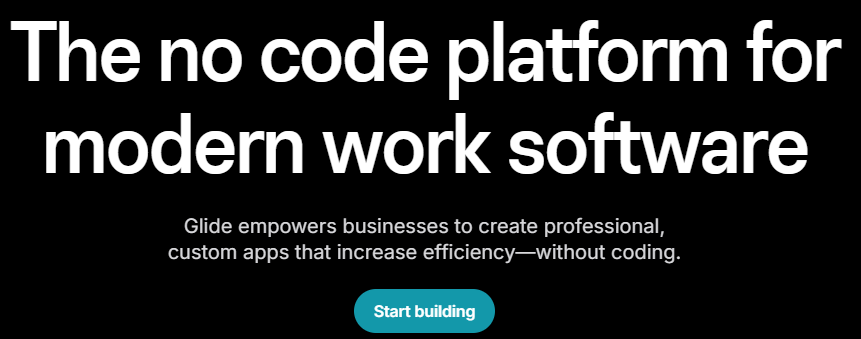
It features 40+ pre-coded blocks and the ability to present internet content directly into Glide apps via web embeds. Users can also apply custom logic to automate mundane tasks or create a single interface that represents information from all the tools a business might use.
Glide also comes with an inbuilt AI engine to fast-track repetitive work such as writing, data extraction and analysis, transcriptions, and more.
Teams can ensure data security by regulating access for app management, editing, and viewing. Additionally, admins can restrict downloading specific rows of data based on users’ email addresses. Likewise, Glide apps can be made available to the general public, specific users, or kept entirely private.
Glide complies with multiple security frameworks, such as PCI, SOC 2 Type 2, FedRAMP, and ISO 27001. It keeps data encrypted in transit and at rest, and the entire platform undergoes regular security audits.
The platform readily integrates with 40+ apps, including Asana, Azure, DocuSign, GitHub, Gmail, Google Analytics, Google Cloud, Hubspot, Outlook, Stripe, OpenAI, Slack, and more.
Glide Pros
Seamless performance on both laptop and mobile devices
Robust security and regulatory compliance
Extensive template library
Glide Cons
Cost is high, especially for lower COL countries
Lacks customizations via code injection
Glide Pricing
Glide has a free plan for individuals that allows publishing one app with 2 collaborators and up to 10 registered users. This plan upgrades to a $49/month plan offering unlimited users, called Maker.
However, businesses must pay north of $99/month to get started, as paid plans offer third-party integrations, AI assistance, API access, and more.
- Team: $99/month
- Business: $249/month
- Enterprise: $499/month
18. Stacker
Best for Customer Portals
Stacker is a no-coding platform for creating software to serve specific business needs. It can help build a custom ERP, CRM, client, or customer portal.
You can start by importing data from Airtable, uploading a CSV, or entering it directly into Stacker Tables. After that, you can configure navigation, user roles, and control data access up to specific fields.
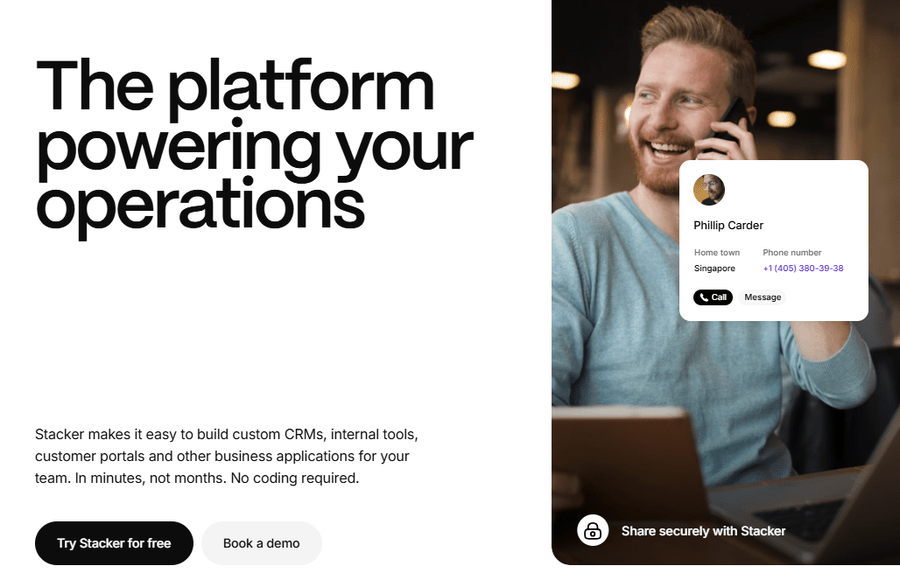
Stacker allows building unlimited apps for every subscription and is collaboration-friendly. Users can inject custom CSS to personalize the app’s interface. Additionally, you can add code extensions to add functionality to your Stacker app.
Teams can use Stacker to create a branded experience with their company logo, colors, custom domain, and single sign-on.
Stacker Pros
Smooth Airtable integration with two-way sync
Superior data control supported with flexible user permissions
Stacker Cons
Interface lags with heavy workload
Extremely limited application
Stacker Pricing
Stacker has custom pricing for its standard plans, but it does allow teams to start for free with a 30-day free trial. However, businesses using Airtable as their database solution have more clarity at their disposal. They have to pay $290/month and $900/month for Pro and Business tiers, respectively. The Enterprise plan comes with custom pricing as well.
19. Carrd
Best for Single-Page Websites
Carrd is an affordable solution for quickly building portfolios, landing pages, etc., with multiple templates and an effortless drag-and-drop workflow. The idea is to create simple websites that look beautiful and professional on all screen sizes.
In addition to using existing templates, users can start with a blank page, build their own, and even share with others.
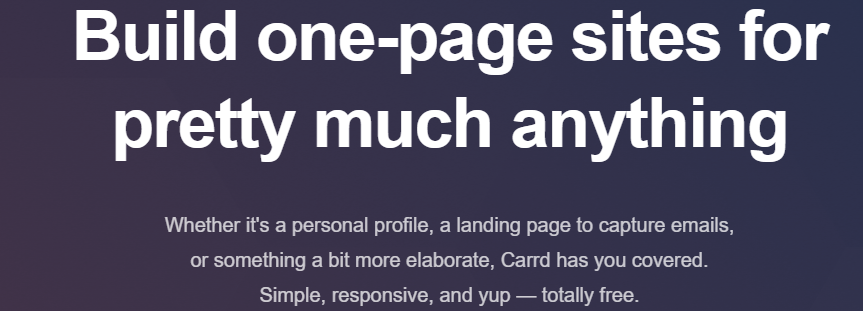
Carrd allows the implementation of Google Analytics, sitemaps, Facebook pixels, UTM parameters, redirects, and more, making it suitable for branded marketing campaigns.
Carrd’s standout feature is its source code export. Moreover, users can transfer their Carrd website ownership to another user with a similar subscription on the platform.
Carrd websites support embedding iFrames, third-party widgets, custom code (HTML, CSS, and JavaScript), audio/videos, forms (with captcha and payment support), and multiple sections (to make it look similar to a multi-page website).
All Carrd pages are fully mobile optimized. Nonetheless, you can opt for manual configuration to control every aspect of the app’s small screen appearance.
Carrd Pros
Wide variety of pre-built templates
Powerful customizations and source code export
One of the best options to create landings and portfolios
Carrd Cons
Not suitable for anyone trying to build a fully-fledged website
Extremely limited set of integrations (PayPal, Stripe, Gumroad, Typeform, and Facebook).
Carrd Pricing
Carrd has a free tier, which lets users build websites with basic templates and publish them at Carrd.co domain. All other offerings come under its paid subscriptions.
- Pro Lite: $9/year
- Pro Standard: $19/year
- Pro Plus: $49/year
Best No-code Platforms Comparison Table
The table below compares the no-code tools on this list based on their use case, features, and pricing.
| No-code Tool | Best Use Case | Features | Pricing |
|---|---|---|---|
| Knack | Small to enterprise-grade web apps | AI-assisted builder, Live guidance from Knack experts, custom CSS and JavaScript | Free trial, $19/month |
| m-Power | Web applications for enterprises | Full code customizations, On-premise and cloud deployment | $1500/month+ |
| Zoho Creator | Internal, web, and native mobile apps for businesses of all sizes | While label app development, content localization, AI-guided building, and flexible data export | Free trial, $8/user/month |
| Bubble | Web apps for SMEs | Custom code injections, GenAI-assisted building, and built-in translation | Free tier, $29/month |
| Mendix | Web and native mobile apps for businesses of all sizes | GenAI integration, on-premises and cloud deployment, uptime guarantee | Free tier, $75/month |
| Quickbase | Web apps for medium to enterprise-level businesses | Fine-grained security, branding control, and AI assistance | Free trial, $35/user/month |
| Retool | Web and mobile apps, internal tools for business | Full code customizations, self and cloud hosting, and GenAI integration | Free tier, $10/standard user/month + $5/end user/month |
| Google AppSheet | Web and mobile app prototypes | Google Workspace integration, AI and ML integration | Free tier, $5/user/month |
| Creatio | Web, mobile, and desktop apps for teams | Script injection, AI/ML models, Cloud/on-premises deployment | Free trial, $25/user/month |
| Airtable | Web apps for businesses | GenAI integration, team collaboration, and fine-grained access control | Free tier, $20/seat/month |
| Microsoft Power Apps | Web and mobile apps for businesses of all sizes | Microsoft 365 and GenAI integration, custom code | Free tier, $20/user/month |
| Caspio | Web apps for businesses | Content localization, GenAI-powered app builder, CDN, granular data access control | Free trial, $90/month |
| Kissflow | Workflow automation for enterprises | Code extensions, translation, IP whitelisting, AI assistance | $1500/month+ |
| Webflow | Websites for individuals and businesses | Source code export, collaboration, custom code injection, content localization | Free tier, $14/month |
| Adalo | Web and mobile apps for startups | One-click publishing to mobile platforms, geolocation support, custom code injection | Free tier, $36/month |
| Softr | Web apps and internal tools for businesses | Code customizations, free custom domain publishing, unlimited visitors, GenAI integration | Free tier, $49/month |
| Glide | Web apps for businesses | AI assistance, embed support, 400+ templates | Free tier, $99/month |
| Stacker | Web apps and internal tools for mid to large-scale teams | Two-way Airtable sync, unlimited apps, custom code | Free trial, $290/month |
| Carrd | Single page websites | Source code export, custom code injection | Free tier, $9/year |
What is No-Code?
No-code is a system that helps users develop software with visual elements, such as drag-and-drop elements and pre-built components, without actually writing code. No-code software serves specific business use cases, such as inventory management, client portals, etc., and helps developers publish at Google and Apple app stores as “standard” apps.
Users get an intuitive interface that allows importing data sources (such as an Excel sheet) and converting them into a working app that supports design customizations.
Types of No-Code Apps
There are multiple types of no-code apps based on their purpose. They can be used for website design, app development, game development, automation building, chatbot building, and more. However, all of those no-code apps can be clubbed into 4 major categories, as indicated below.
- Web Development Platforms: These are no-code apps that allow website development without coding. Wix, Hostinger, Webflow, and Squarespace fall into this category.
- Mobile App Builders: No-code mobile app builders like Adalo enable users to create applications for iOS and Android from pre-built code blocks.
- Automation Tools: Software like Zapier and Make (formerly Integromat) help users connect different apps to automate mundane action sequences (such as saving a contact after a form gets filled).
- Database Builders: These no-code apps are best for managing data and creating applications on top of them. Airtable is a good example of a database builder no-code platform.
How to Choose the Right No-Code App Builder?
Ease of use, scalability, security, and integrations are some of the crucial factors in choosing the right no-code add builder, as discussed below.
- Ease of Use: The major appeal of a no-code builder is the app development process, which should be effortless. After all, users aim to build apps without experiencing unresponsive and buggy user interfaces. The best place to learn about this before trying these app builders yourself is through user feedback at public forums like G2, Trustpilot, and Reddit.
- Scalability: It’s critically important to know the usage ceilings, as most no-code apps are hosted on shared servers. This can slow down the experience after user traffic reaches platform-imposed ceilings. Moreover, the cost of upgrading to the next tier can be unattractive for a startup. Therefore, teams must know about the usage/price before choosing the app of their choice.
- Security: No-code apps are primarily used by teams lacking in-house developers, let alone a dedicated cybersecurity department. This means security mostly takes the back seat, with the authors having minimum insight into how the specific no-code platforms handle user data. At the minimum, teams must ensure the platform’s compliance with local and industry-specific security frameworks, such as GDPR, CCPA, and HIPAA.
- Integrations: Since companies use many applications (on-premise and cloud), you must confirm if the no-code platform easily connects with them. Users should especially note if the service integrates with the web security platform of their choice.
- Design Preferences: Users want their apps to stand out from the plethora of apps available online. Plus, every app should convey the brand identity, like the rest of the institutional assets. This can only be made possible if the no-code builder enables design customization.
- Functionality: The biggest issue with no-code development workflows is that users can only have limited complexity/functionality within their apps. While the situation is improving as we speak of it, there are still some platforms, such as Carrd, Knack, and Softr, which are meant for simpler developments.
- Export Options: The ability to export code from a no-code platform allows backup, customizations, and switching to a different vendor if required. Moreover, it allows teams to conduct security audits to find critical vulnerabilities. However, most platforms don’t allow exporting entire data all at once, imposing a certain degree of vendor locks. You must look for data export, even in parts, in their desired format.
- Drag-and-Drop vs. Code Blocks: Drag-and-drop presents the simplest alternative to writing code, whereas code blocks are a visual way of programming. The former is best suited for someone with no intention of switching to traditional coding, while the latter is great for more coding flexibility and learning.
- Pricing: Most no-code app platforms offer a free tier to start with. However, what’s more important is the cost of the paid tier versus the value (i.e., resources) you get. This is particularly important for business use cases since you can’t work with the limited-features free tiers for long.
FAQs
The most common features of no-code development platforms include a drag-and-drop interface and pre-built code components. These platforms allow real time collaboration and integration with third-party services and tools. No-code platforms also come with ready-to-use, customizable app templates to simplify the process for non-technical users.
The ideal no-code target audience is someone not familiar with programming, such as business professionals and citizen developers. However, most no-code platforms also allow custom code injection (making them low-code tools), enabling startups to build minimum viable products (MVPs) to later expand upon.
Zero code is essentially the same as no-code, which means software development done through a visual interface and pre-built elements, without writing a single line of code.
No-code development approach is worth it for non-programmers or businesses trying to quickly build prototypes.
However, no-code platforms also have their fair share of issues, such as limited customizations, vendor locks, and the sheer inability to let users make complex apps.
Consequently, it’s great to start with no-code, but learning to code alongside gives one complete control of every aspect of their projects.

